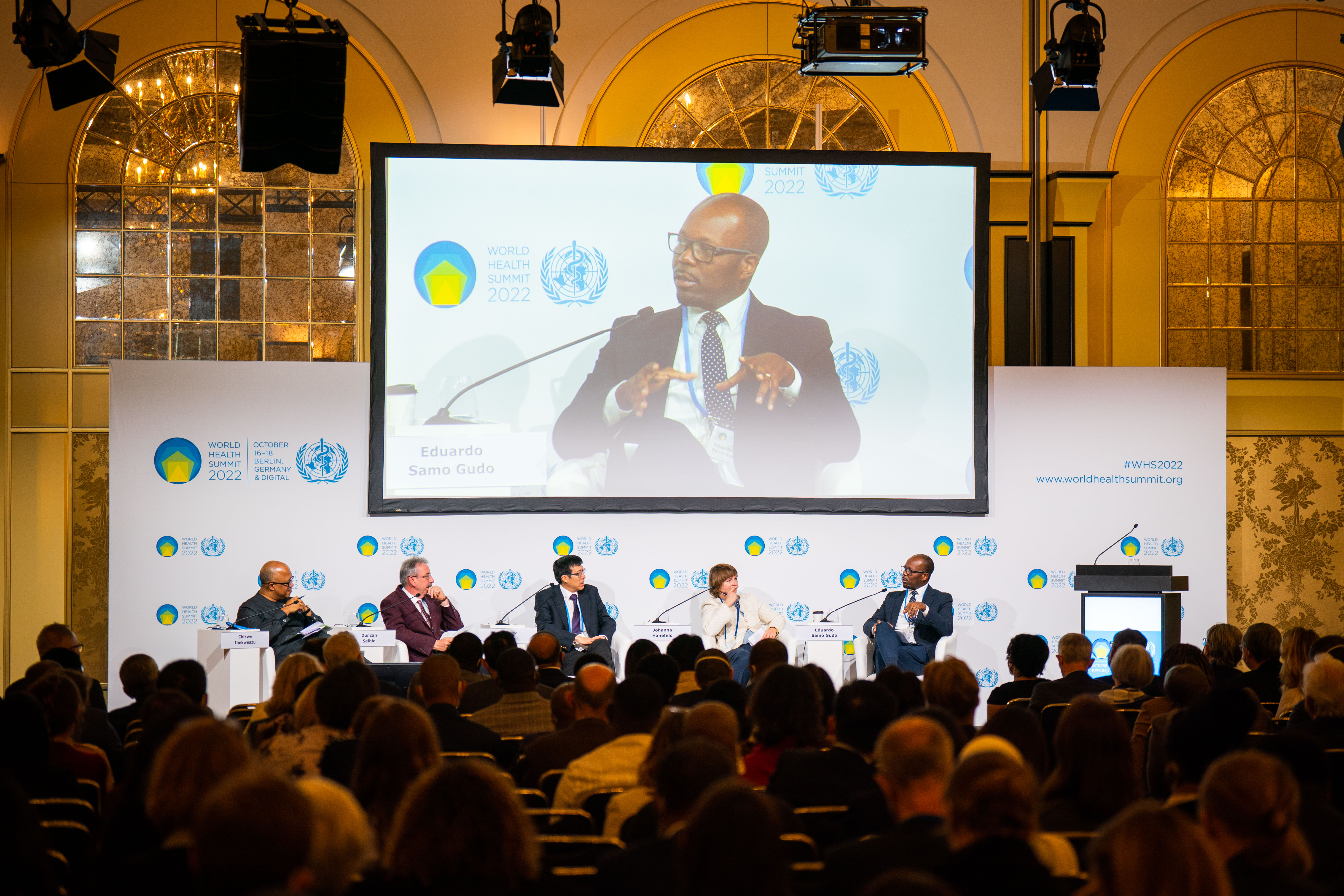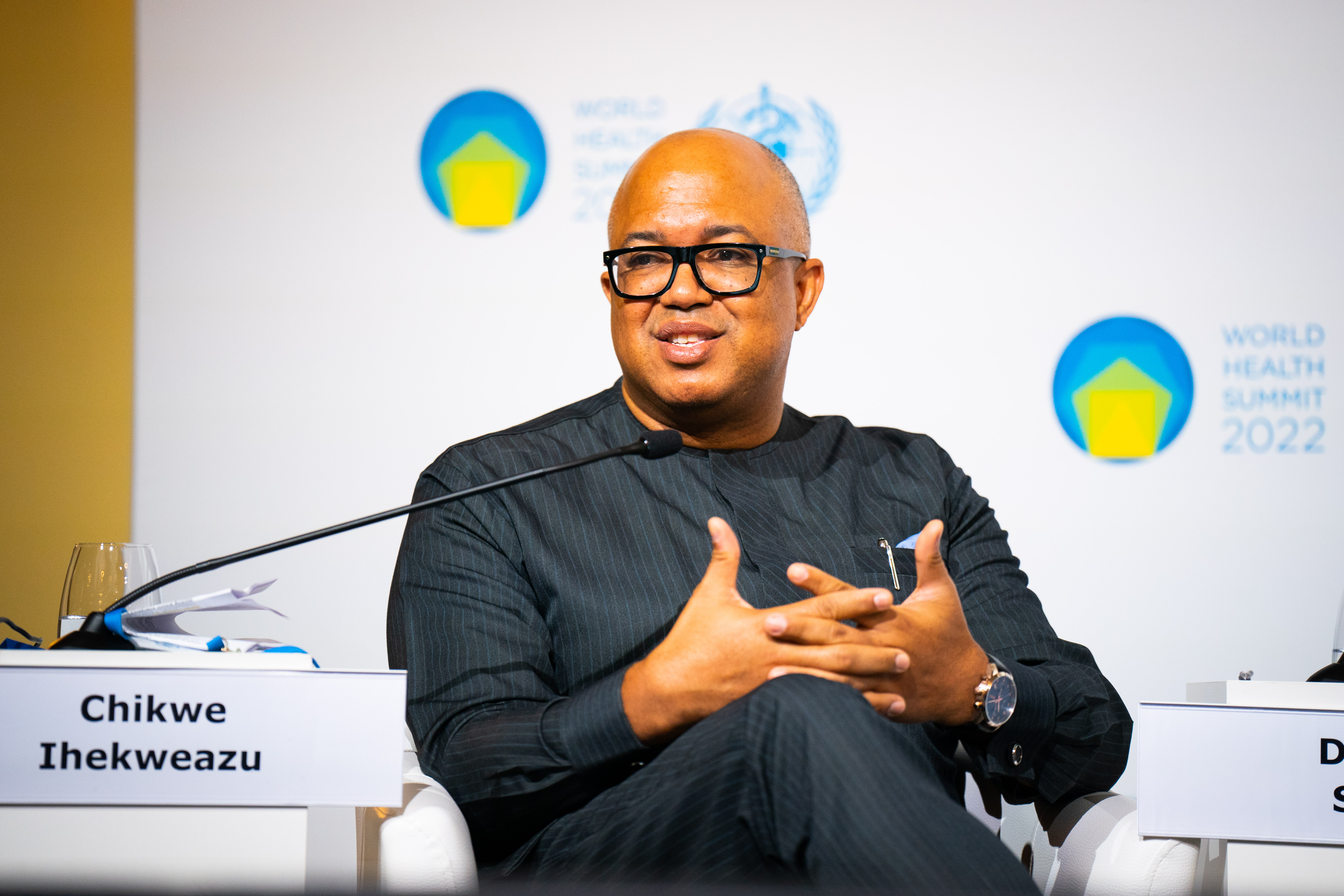Outsmarting Pandemics: Collaborative Surveillance and the Role of NPHIs - Highlights of the World Health Summit
On October 16, 2022 in Berlin, IANPHI and several member institutes took part in the first session of the World Health Summit 2022 on “Outsmarting Pandemics: Collaborative Surveillance and the Role of Public Health Institutes”, hosted by Dr. Chikwe Ihekweazu, assistant director-general of the World Health Organization (WHO), leading the WHO Hub for Pandemic and Epidemic Intelligence.
The COVID-19 pandemic has exposed weaknesses in disease surveillance in nearly all countries. The complex challenge to outsmart pandemics requires profoundly robust healthcare systems globally as well as a collaborative, coordinated preparedness regarding multiple disease areas with pandemic potential. A new model is needed for the surveillance of emerging threats, which builds upon traditional surveillance approaches but also incorporates epidemic intelligence, genomic surveillance, behavioral and social insights, and surveillance at the animal-human interface.
Central to the notion of collaborative surveillance – and response – are National Public Health Institutes (NPHIs), accountable for detecting public health threats, enabling public health decisions, defining and monitoring the response. NPHIs have a role of convener, influencer and connecter at the national level, IANPHI President Duncan Selbie explained during an introductory discussion to the session with Dr. Ihekweazu.
While obstacles to collaboration remain in several settings, many NPHIs have innovated in the face of the pandemic’s challenges, presenting an opportunity to learn from best practices and to foster greater global collaboration to keep the world safe.
A recent survey of IANPHI members on integrated disease surveillance (IDS) revealed that the idea of integration varies from country to country and can apply either to data systems, IT systems, analysis, or the response itself, according to Prof. Dr. Andrew Lee, consultant in health protection and national COVID-19 incident director at the United Kingdom Health Security Agency, who has been working with IANPHI on the research project. A common theme was how collaboration and integration of data from different health and non-health sectors is seen as a vehicle to a better use of data, better analysis and better decisions to protect the public.
Several key IDS building blocks were identified in the survey, including defining the purpose of the IDS system, the need for infrastructure (IT, lab and data systems, protocols and procedures), sustainable financing, leadership and supportive legislation, and learning from different sectors and peers. Survey responses also showed that people are the glue that holds the system together. Trust and established inter-professional relationships are of paramount importance.

View of the stage, Dr. Eduardo Samo Gudo speaking
Credit: World Health Summit
Prof. Johanna Hanefeld, head of the Department for International Health Protection at Germany’s Robert Koch Institute (RKI), shared insights into RKI’s own recent work on IDS, with a focus on workforce training. She pointed out the lack of coordinated effort in training at the national level. Field epidemiology training programs have shown during the COVID-19 pandemic how well they work. A multidisciplinary approach to training programs inspired by that model could help build capacity for specialties beyond field epidemiology, such as laboratory for genomics surveillance, and community engagement and risk communications. NPHIs are the custodians at the national level, she added. “We need the strong NPHIs, but we need to take a critical look at what we’re doing the surveillance for and what we’re training for”.
Simultaneous health emergencies have led to the fragmentation of the surveillance system in Mozambique, said Dr. Eduardo Samo Gudo, deputy director general of the Instituto Nacional de Saúde (INS). INS established a national health observatory, a multidisciplinary platform which integrates surveillance, data and a multidisciplinary workforce. The integration work started with climate change and health, a national priority for Mozambique as one of the African countries most affected by cyclones. “We need to shift the paradigm at country level,” Dr. Gudo said, in order to encourage true multi-sectoral approaches and stop thinking in siloes.
In South Africa, the National Institute for Communicable Diseases (NICD) rapidly upscaled polio environmental surveillance using the platform for COVID-19 surveillance during the pandemic as part of an early warning system. To succeed, NICD collaborated with other NPHIs, learning from the Netherlands, Israel, and Ghana, Dr. Natalie Mayet, deputy director of NICD explained. The South African institute then shared its experience with Africa CDC and engaged with stakeholders and communities at national level. The experience “demonstrates the collaborative synergy of multiple systems across the surveillance network that we can all use to inform policies and behavioral decision making,” she said.
To have global health security, Prof. Lee reminded, surveillance needs to be strengthened at all levels down to the district and local level. The IANPHI survey found that high-income countries were more likely to have NPHIs. Countries with more developed integration of disease surveillance were more likely to have NPHIs involved in leading, co-leading and taking accountability. “We need an organization that will take accountability and leadership and act as a pool of expertise, help bring together people across different sectors, so that they can share and learn and build expertise together”, he said.

Prof. Duncan Selbie
Credit: World Health Summit
Dr. Ibrahima Socé Fall, assistant director-general of WHO for emergency response, who shared having worked on countless outbreaks – “I stopped counting when I reached 500 in 2019”, moderated the last segment of the session.
Prof. Dr. George Fu Gao, former director-general of the Chinese Center for Disease Control and Prevention and member of the IANPHI Executive Board, discussed China’s ‘Zero COVID’ strategy. Three components are needed in any public health emergency, he said, and those are science, public understanding, and leadership. To improve current systems, he added, “we need international collaboration and international coordination.”
Prof. Geneviève Chêne, chief executive of Santé publique France and member of the IANPHI Executive Board, shared examples of initiatives taken by the French public health agency to improve IDS during the pandemic. Collaborative and integrated surveillance using data from different networks and relying on strong partners to interpret the data led to the use of no less than 120 indicators to analyze trends. Santé publique France was also able to scale up genomic surveillance by building a consortium of surveillance and research networks. As 3,000 sequences were performed in 2020, that number rose to more than 550,000 in 2021 and 2022 – a resounding success.
Among the lessons learned, Prof. Chêne highlighted the need for closer links with research networks and communities to facilitate the use of science-based evidence in actionable policies. “It’s the work of NPHIs to be concrete and operational and closer links with research are very important,” she said.
“Whatever good and bad coming out from the COVID-19 crisis must be immediately translated into strategies and policies,” said Prof. Aamer Ikram, executive director of Pakistan’s National Institute of Health (NIH) and member of the IANPHI Executive Board. The Pakistani government established a national coordination and operation center at the start of the pandemic. The center was a key success for the country as it provided a multidisciplinary platform for all stakeholders, including NGOs and the academia. NIH also established a center for genomics during the crisis, which is now being utilized for diseases other than COVID-19.
Other successes were achieved with diagnostics and vaccines. NIH started with very few tests available at its headquarters only and progressed to having more than 200 laboratories performing PCR testing. Pakistan has also immunized nearly 90% of its eligible population. Prof. Ikram shared that Pakistan’s integrated surveillance and response system, developed four years ago, was now being utilized to manage the response to the catastrophic flooding the country is still facing.

Dr. Chikwe Ihekweazu
Credit: World Health Summit
Concluding the session, Prof. Selbie emphasized the value of experience sharing between NPHIs and countries – and the value of a network like IANPHI. “We want to see strong public capabilities in every part of the world,” he said. Dr. Ihekweazu added that it was important for the global health community to invest in every part of the chain.
__________
The World Health Summit is a unique international strategic forum for global health held annually in Berlin in partnership with WHO. It brings together stakeholders from politics, science, the private sector, and civil society from around the world to set the agenda for a healthier future by inspiring innovative solutions for better health and well-being for all. The World Health Summit was founded in 2009 on the occasion of the 300th anniversary of Charité – Universitätsmedizin Berlin. It is traditionally held under the patronage of the German chancellor, the French president, the president of the European Commission, and the director-general of WHO.